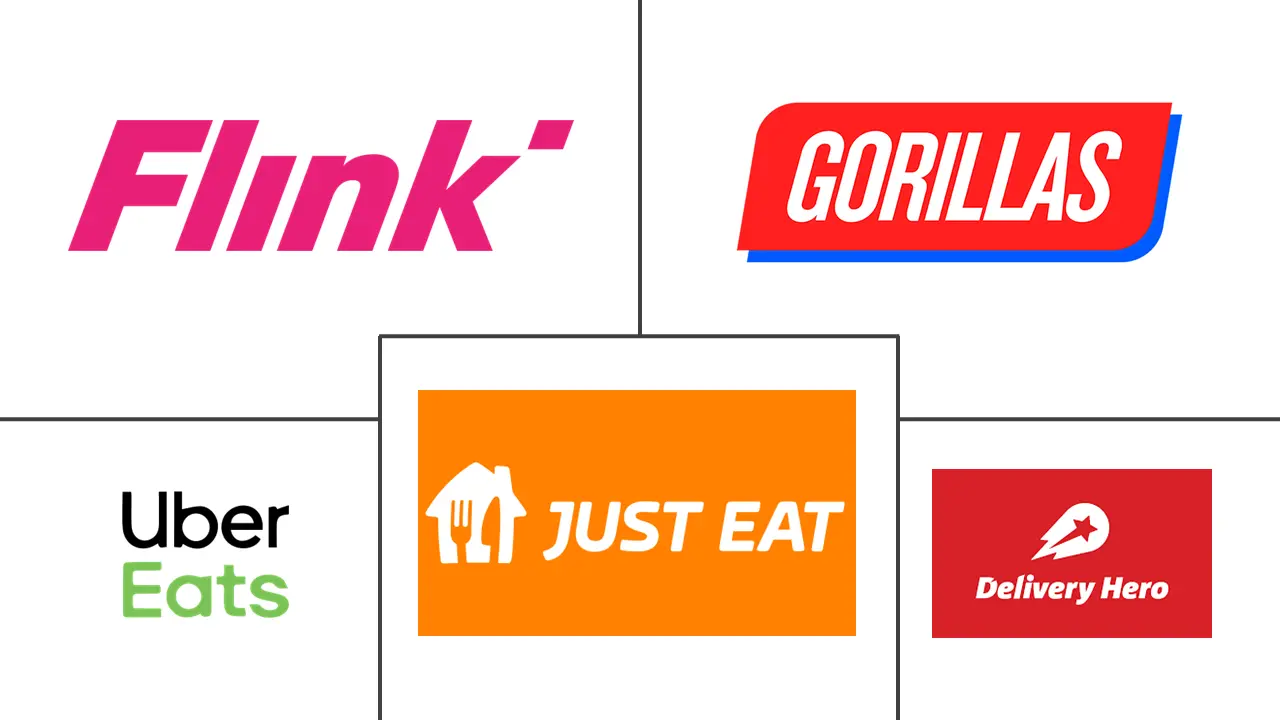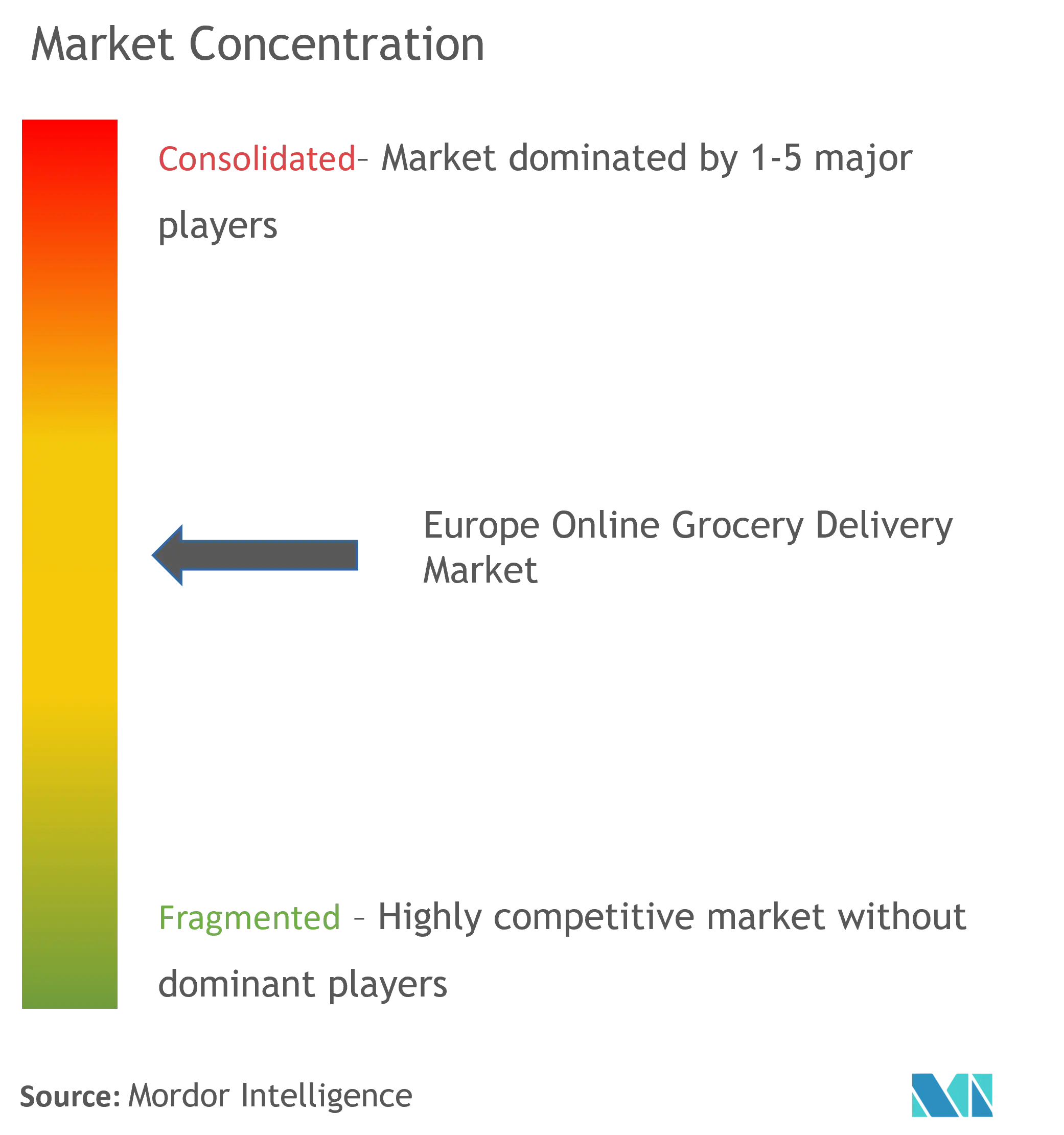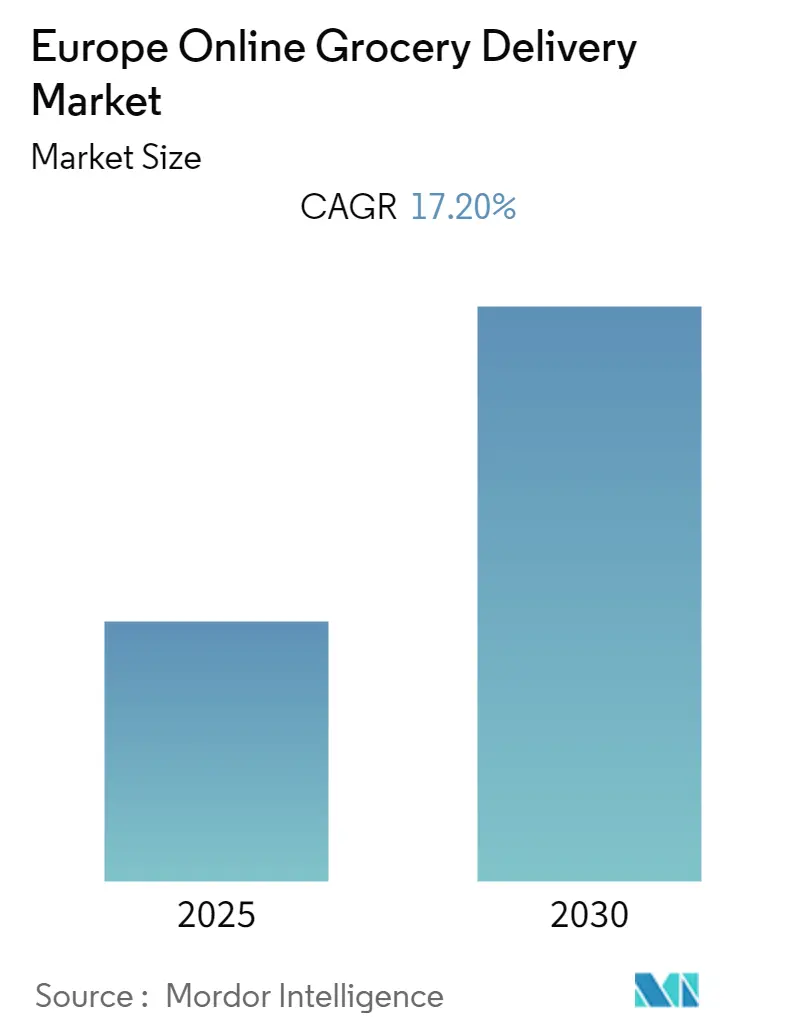
Europe Online Grocery Delivery Market Analysis
The Europe Online Grocery Delivery Market is expected to register a CAGR of 17.2% during the forecast period.
- Online grocery ordering has become increasingly popular in recent years. One of the primary drivers of market growth is the increasing proliferation of smartphones and internet connections, which allow for very easy and speedy meal delivery. According to GSMA Intelligence, 474 million individuals in Europe (86% of the population) subscribed to mobile services in 2021, and this figure is predicted to rise to 480 million by 2025.
- The incorporation of IOT enables consumers to select online grocery delivery services using voice commands, thereby simplifying the delivery procedure. Such technological advancements are expected to propel the market under consideration. IoT connects businesses to restaurants, allowing them to provide quick delivery. For example, there may be days when they have larger orders that must be fulfilled within a specific time frame. The only thing that matters to a person when making a purchase is their online experience. It must be flawless from the very first use.
- According to Otter, a delivery management and optimization platform survey conducted between January and June last year stated that people throughout the UK like ordering on weekends. The busiest day for delivery is Sunday (16.5% of all orders), followed by Saturday (16.4%) and Friday (16.3%). The number of orders is stable at the start of the week, with a little increase on Thursday. In terms of hours, the most popular time to order delivery is at night, with the 7 to 8 p.m. timeframe leading the way.
- The COVID-19 pandemic benefited the industry since it promoted the usage of online grocery delivery services as millions of individuals were instructed to stay at home to contain the health catastrophe. During the COVID-19 pandemic, the online grocery platform became one of the key players. Delivery services grew rapidly as people ordered more fast food during the pandemic. UberEats dominates the French takeout delivery industry. Still, Deliveroo tripled its subscribers by giving unlimited deliveries for a tiny introductory price of USD 1, rising to USD 5.99 at the end of the second year.
- On the flip side, apart from the consumer base, food expenses are also highly unpredictable. Several variables influence food pricing. Food delivery companies frequently struggle to keep up with market prices and establish a proper pricing strategy. Along with inflation and the mounting revenue shortfalls of its partners, food delivery services must focus on implementing offensive or defensive pricing methods to compete. This puts even more pressure on margins and has an impact on profitability.
Europe Online Grocery Delivery Market Trends
Attractive Offers and Payment Flexibility to Boost the Demand of the Market
- There are numerous payment options available in Europe. There are also countless local players. Customers frequently prefer these over prominent international players. As a result, merchants often collaborate with one of the many payment providers with a gateway to many payment systems. According to research by Payvision, European consumers prefer using digital wallets (44%). This is followed by payments by card (42%), and PayPal is in third place (32%).
- A study by Divido indicated that about 17% of consumers in the country agreed that the availability of different finance options was essential. About 36% admitted they would like to shop again at a retailer offering such opportunities. At the same time, retailers see up to 30% more sales and benefits like repeat purchases, more loyal customers, and more basket conversions when they offer the above feature.
- In the Netherlands, more people are going cashless for online and offline payments. According to the Dutch Central Bank, only 20% of payments made last year in the country were made with cash, which is among the world's lowest. To leverage this growing opportunity, tech firms, credit card companies, and the government launched a variety of mobile payment services. Further, the average purchase cost was USD 21.64 before the coronavirus pandemic. Over 18% more was spent at checkout counters by Dutch shoppers, who paid an average of USD 25.55.
- Saving money when dining out isn't always straightforward; most restaurant promotions aren't valid every day of the week or only apply to particular areas of Spain. For instance, La Tagliatella. Download the app and sign up to receive a USD 20 discount voucher to be used on the user's birthday. In addition, Pans & Company Pans & Company's app is available in English; download it to receive 200 points, and then for each order, the user receives 5 times the euro value in points.
- According to Paysafe Group, in the past year, inflation has influenced payment habits for online purchases in Germany, with four out of ten respondents now using a credit card. According to a poll conducted in ten countries across North America, Europe, and Latin America, the cost of living had no effect on payment behavior in those countries. Credit cards, BNPL, and cryptocurrency were all used more frequently. Still, neither saw the greatest increase: 52 percent of respondents who changed their payment habits due to higher living costs in the last year are paying online with debit cards more frequently than they did the previous year.
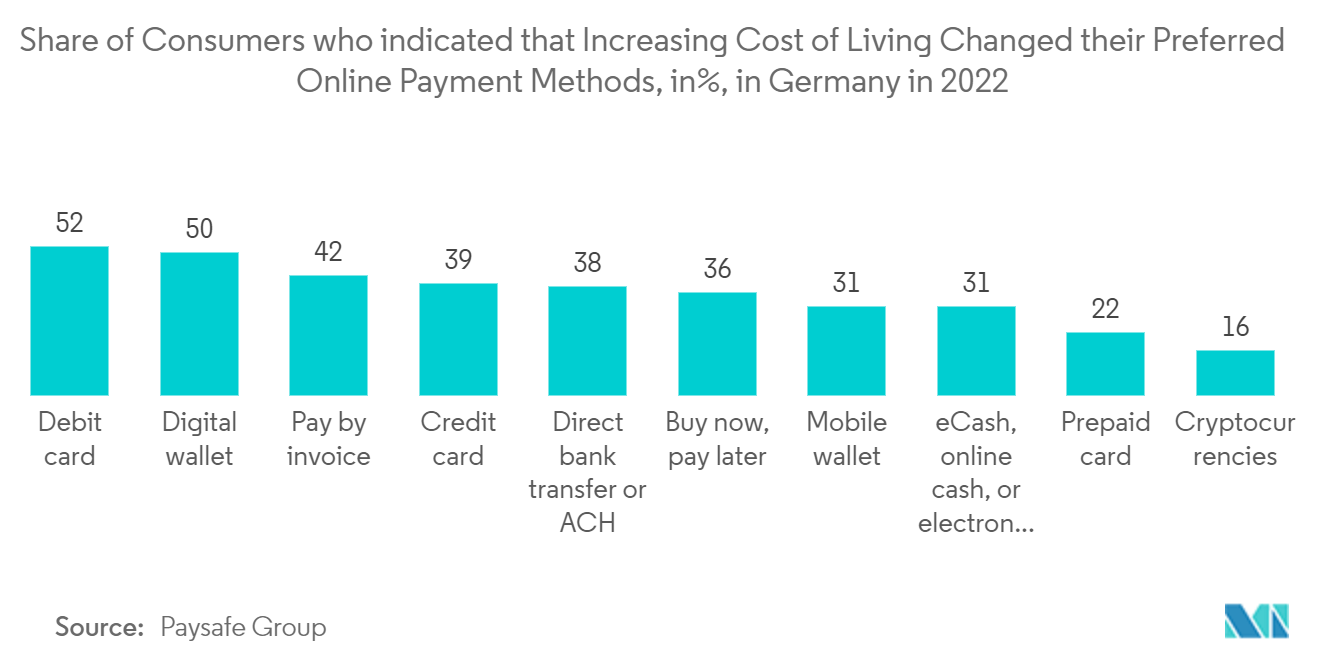
United Kingdom is Expected to Observe a Significant Growth
- Recognizing existing regulatory loopholes in online food sales, the UK Food Standards Agency (FSA) has collaborated with three of the country's top online food delivery platforms to create a new Food Safety Charter. The charter requires Just Eat, Uber Eats, and Deliveroo to make sure that the 170,000 businesses that provide food through their services are registered with their local authorities and meet the essential requirements of the Food Hygiene Rating Scheme.
- In January last year, Jiffy announced "Jiffy Q-Commerce as a Service," allowing brands and retailers to offer sub-15-minute delivery of their products through their own DTC site while utilizing Jiffy's ordering system and fulfillment network. Brewdog is the program's first partner, and it is working with Jiffy to set up a service that delivers beer very quickly.
- Recently, dispatch, based in London, has become best known for its finish-at-home meal kits. The startup recently received a USD 10 million seed round led by Andreessen Horowitz and LocalGlobe. The cash will allow an additional 20 eateries to join the platform by the end of this year, enhancing customer options. Dishpatch will also expand its personnel in marketing, technology (including platform development and packaging technologists), distribution, and customer service.
- According to Otter, Brits spend an average of USD 21.29 on each delivery order, but they're willing to splurge somewhat more on weekends. The average spending by meal reveals larger disparities. Later in the day, they spend more money, whereas early meals remain under USD 20. This fast-increasing number of cloud kitchens is projected to fuel the online meal ordering trend, which is good news for the industry's growth.
- The platform-to-consumer strategy addresses logistics and resource issues in grocery delivery while also providing shipment services to grocery stores that do not have in-house delivery resources. During the projected period, an increase in the number of investments of this type is expected to drive the growth of this category, primarily in major cities. The restaurant-to-consumer industry handles the shipment aspect, while online meal delivery service providers handle the ordering procedure. To reach this sector, firms using this strategy offer consumers loyalty and subscription programs. The integration of several restaurant chains with aggregators like DoorDash promotes industry growth even further.
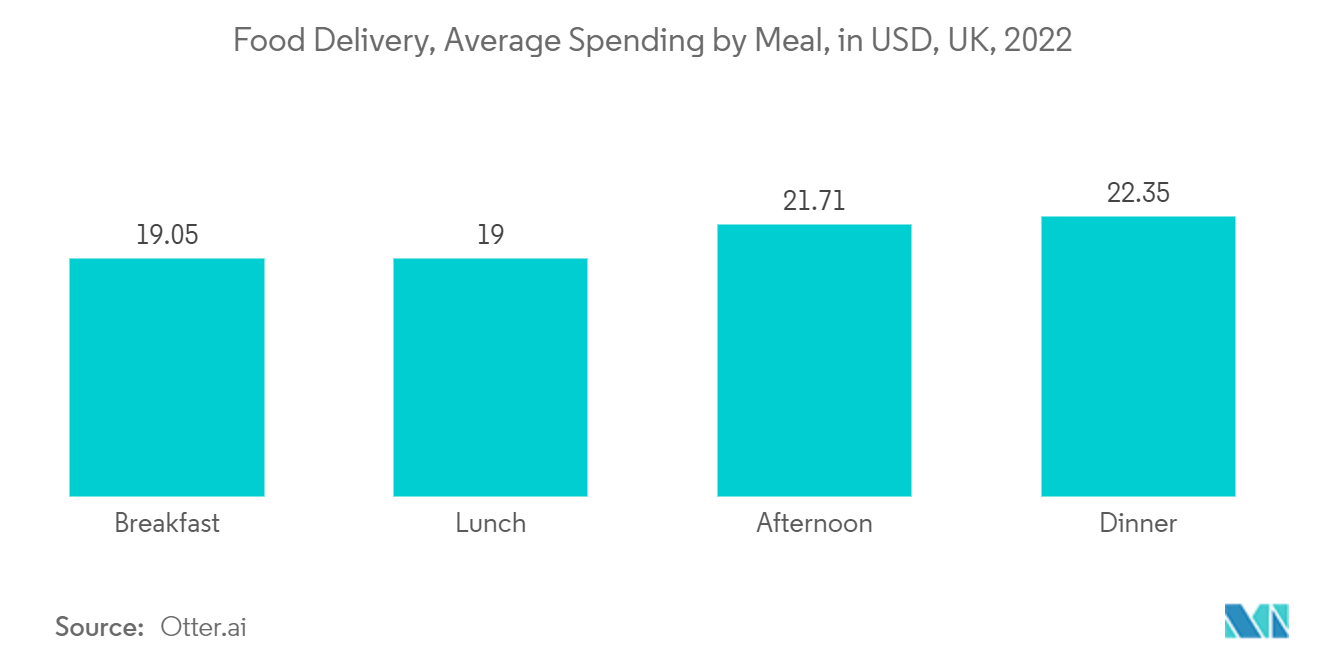
Europe Online Grocery Delivery Industry Overview
The European online grocery delivery market is moderately competitive owing to the presence of multiple players. Players in the market use strategies like coming up with new products, merging with other companies, and buying other companies in order to grow their product lines, reach more places, and stay competitive in the market.
In March 2022, The Casino Group and Just Eat France will collaborate to make life easier for French citizens by delivering food to their doors in 30 minutes. Just can match consumer expectations even better because of its cooperation with the Casino Group in France. This agreement covers the group's French food brands, such as Franprix, Monoprix, Vival, Le Petit Casino, La Nouvelle Cave, and others.
In February 2022, after announcing an international commercial deal, France-based food retailer Carrefour and European online grocery marketplace Everli expanded their partnership to ten towns in France. Carrefour's hypermarkets and supermarkets will be available on Everli in Lille, Lyon, Nice, Toulouse, Bordeaux, Montpellier, Nantes, Grenoble, Rennes, and Paris, as well as their neighboring districts. Consumers in these locations can order up to 25,000 products from over 140 local retailers and have them delivered on the same day.
Europe Online Grocery Delivery Market Leaders
-
Flink
-
Just Eat
-
Delivery Hero
-
Uber Eats
-
Gorillas
- *Disclaimer: Major Players sorted in no particular order
Europe Online Grocery Delivery Market News
- January 2023: Sainsbury's, the UK's largest supermarket chain, has partnered with online meal ordering and delivery service Eat Takeaway to provide speedier home delivery for groceries across the country. Customers can order things from Sainsbury's for delivery in under 30 minutes using the Just Eat app. The cooperation will begin with more than 175 stores by the end of February, with a nationwide rollout planned for 2023.
- February 2022: Rohlik Group, a Czech online grocery delivery company, has extended its German business, Knusper.de, by opening in Germany's Rhine-Main Metropolitan Region. Customers in and around Frankfurt, Mainz, Wiesbaden, and Darmstadt have begun to place orders with the company. Customers in these places can buy more than 9,000 different items. About 30% of these items come from local butchers, bakeries, and wineries.
Europe Online Grocery Delivery Industry Segmentation
An online grocer is either a physical supermarket or grocery store that accepts online orders or a separate e-commerce operation that sells grocery items. This service normally comes with a delivery fee. Online grocers are traditional supermarkets that have created internet channels to serve their customers better.
The Europe Online Grocery Delivery Market is divided into product types (retail delivery, quick commerce, meal kit delivery) and countries (the United Kingdom, Germany, France, Spain, and the Rest of Europe).
The market sizes and forecasts are provided in terms of value (USD million) for all the above segments.
| By Product Type | Retail Delivery |
| Quick Commerce | |
| Meal Kit Delivery | |
| By Country | United Kingdom |
| Germany | |
| France | |
| Spain | |
| Eastern Europe | |
| Rest of Europe |
Europe Online Grocery Delivery Market Research FAQs
What is the current Europe Online Grocery Delivery Market size?
The Europe Online Grocery Delivery Market is projected to register a CAGR of 17.2% during the forecast period (2025-2030)
Who are the key players in Europe Online Grocery Delivery Market?
Flink, Just Eat, Delivery Hero, Uber Eats and Gorillas are the major companies operating in the Europe Online Grocery Delivery Market.
What years does this Europe Online Grocery Delivery Market cover?
The report covers the Europe Online Grocery Delivery Market historical market size for years: 2019, 2020, 2021, 2022, 2023 and 2024. The report also forecasts the Europe Online Grocery Delivery Market size for years: 2025, 2026, 2027, 2028, 2029 and 2030.
Our Best Selling Reports
Europe Online Grocery Delivery Industry Report
Statistics for the 2025 Europe Online Grocery Delivery market share, size and revenue growth rate, created by Mordor Intelligence™ Industry Reports. Europe Online Grocery Delivery analysis includes a market forecast outlook for 2025 to 2030 and historical overview. Get a sample of this industry analysis as a free report PDF download.

